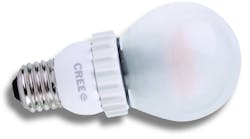Download this article in .PDF format
This file type includes high resolution graphics and schematics.
I just finished putting corn gluten meal on my lawn. I do it every spring and fall. In the spring it acts as an organic, pre-emergent weed control that stops seeds from growing. This includes weeds and grass, so it cannot be put on newly planted grass. Then again, in most places in the northern United States you should only be planting grass in the fall.
The trick with corn gluten meal, or almost any pre-emergent herbicide, is timing. Put it down too late and the weeds will already be growing. The fertilizer then helps the grass and the weeds. Put it down too early and the protection it provides can run out.
Timing is also critical for the success of LED lighting.
Standard LED Lighting
In a sense, the success of cold cathode fluorescent lamps (CCFLs) and LEDs is due to government mandates. These technologies are more energy efficient and cost less in the long run, but they have a much higher upfront cost compared to the significantly less efficient Edison light bulb, which has seen limited improvement over the years.
The new laws established standards that must be met. These standards are slightly different from others that might specify a particular socket or frequency, though companies still have to deliver products that meet them.
The high costs of CCFLs and LEDs are one reason they didn’t show up earlier and on their own. There were markets where they existed, but the larger consumer market was essentially ignored.
Cree made a big splash when it started shipping LED light bulbs for $10. The 9-W version costs a bit more but matches the output of a 60-W incandescent bulb (see the figure). The current prices are significantly lower than they were when these types of bulbs were first introduced a couple of years ago. They now have to compete with CCFLs, which were first out the chute and dominate store shelves today.
LEDs needed to address a number of challenges. They’re inherently small, so most conventional lighting applications require multiple LEDs. Standard light bulbs have dozens of LEDs inside. Yet LEDs have many advantages over CCFLs. They are easier to dim, and they have attributes that have opened new venues.
LEDs Deliver New Options
CCFLs provide more configuration options than incandescent bulbs, but their support hardware and general construction limit their possible deliverables. LEDs have fewer limitations. They can be extremely small, and their color gamut is much wider. They also can be adjustable, providing even more options unavailable to CCFLs and incandescents.
The number of products that already exist is changing the entire lighting arena. Take aquarium lighting, for example. I recently replaced a fluorescent lighting system for my fish tank with an LED-based solution. The new light system is a single device with no removable lights versus the two tubes from the original system, which had replaced the incandescent bulbs I had used decades ago.
The LEDs aren’t replaceable, but there are lots of them. The theory is that the lighting system will still be viable even if a few of the LEDs die. The LEDs are adjustable, and there are two types of them to provide efficiency and color options. The system can even mimic sunrise and sunset.
The resulting system will probably last as long as the tanks and definitely longer than the fish. The amount of power used will be significantly lower too. The lights are also cooler, which is an issue even for tropical fish.
Another application area that has seen significant change is under-cabinet lighting in areas such as kitchens. Here, the LED’s small size and low dc power requirements are major advantages. It’s easy to use a string of LEDs to provide more controlled lighting placement. Color and intensity control are added benefits that would be impractical or very costly with other lighting technologies.
Another aspect to LED solutions is microprocessor control. It is a lot easier than dealing with any other lighting technology. There are challenges, and optimized designs like Cree’s are beyond the average designer. However, the opportunity to incorporate more sophisticated lighting technology now exists. LED and microcontroller vendors provide plenty of app notes to help you get started.
Also, keep an eye out for quantum dots (see “QuantumFilm Increases Camera Efficiency” at electronicdesign.com). They can increase the brightness and extend the color gamut of LEDs. The problem is that making an efficient and cost effective LED for arbitrary colors isn’t as easy as one might think.
Different technologies are employed for different color LEDs. Quantum dots have different absorption and emission spectrums that are often easier to customize to complement LEDs. Full-spectrum white light from low-cost LEDs could be on the horizon.
So ditch your old bulbs and those chemical fertilizers and stock up on LED bulbs and corn gluten meal. In the long run, they’re better for the planet and the pocketbook.
This file type includes high resolution graphics and schematics.


